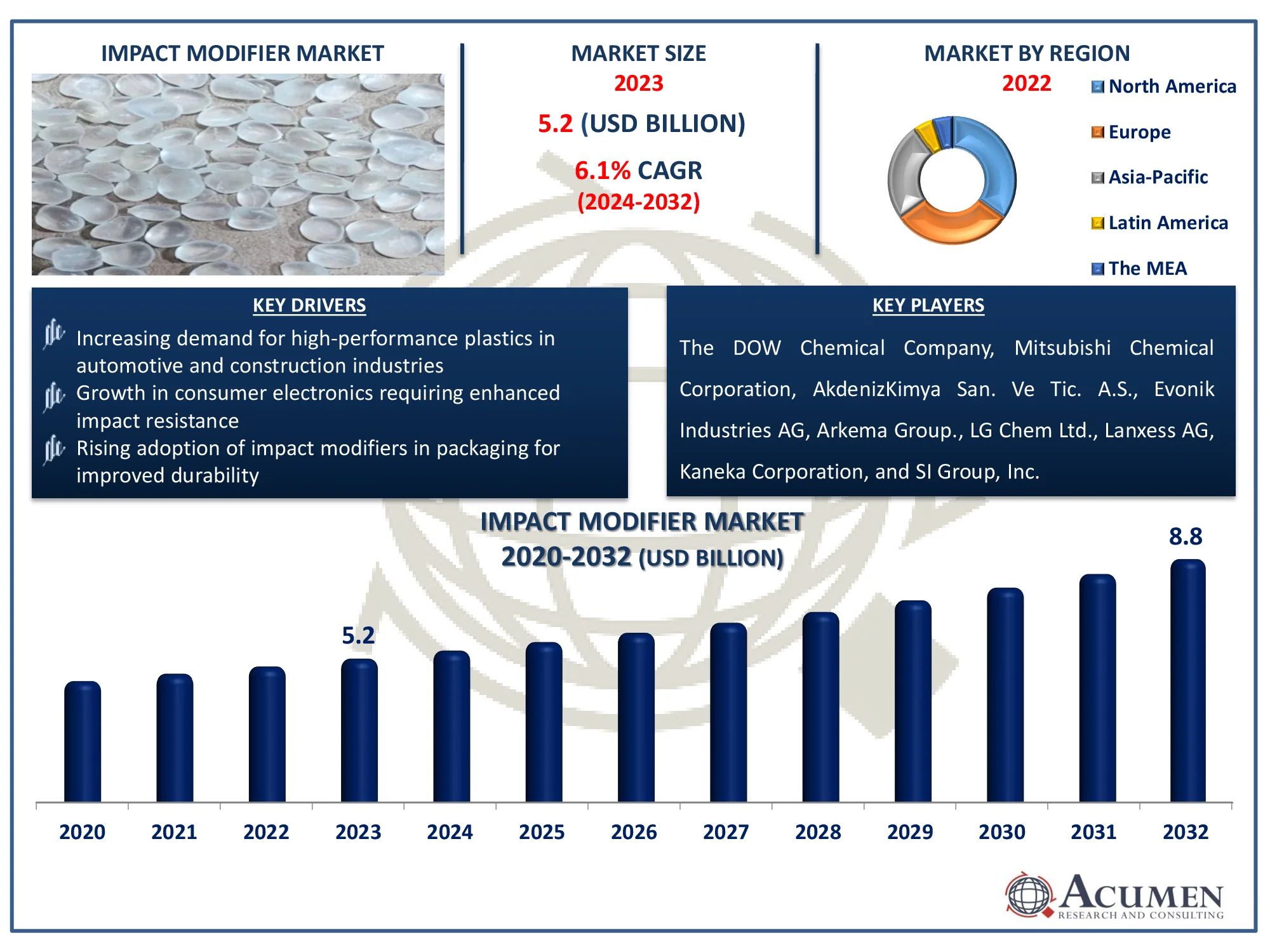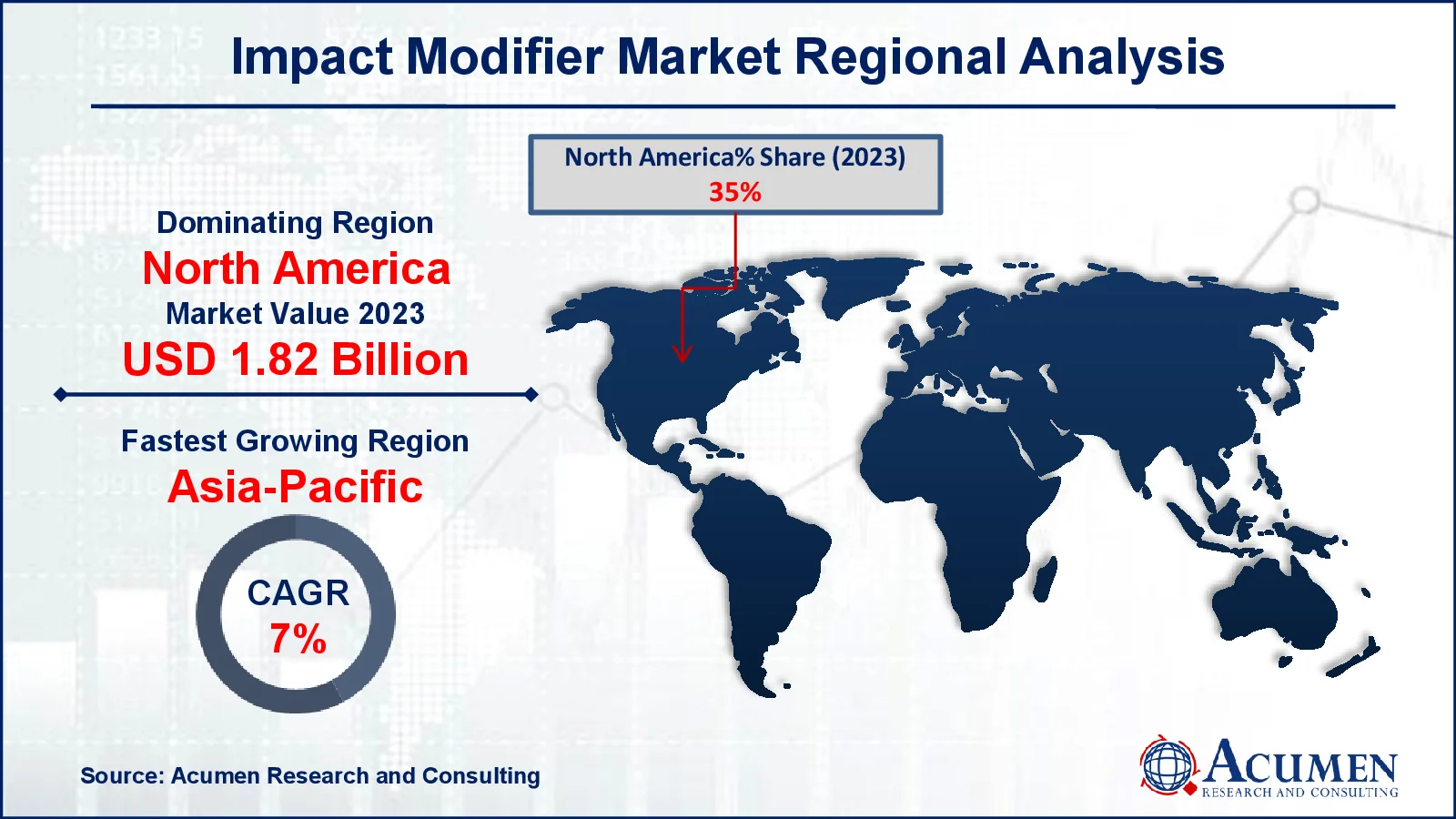Impact Modifier Market | Acumen Research and Consulting
Impact Modifier Market Size - Global Industry, Share, Analysis, Trends and Forecast 2024 - 2032
Published :
Report ID:
Pages :
Format :
The Global Impact Modifier Market Size accounted for USD 5.2 Billion in 2023 and is estimated to achieve a market size of USD 8.8 Billion by 2032 growing at a CAGR of 6.1% from 2024 to 2032.
Impact Modifier Market (By Product: Acrylonitrile Butadiene Styrene, Acrylic Impact Modifiers, Acrylonitrile Styrene Acrylate, Methacrylate-Butadiene-Styrene, Ethylene Propylene Diene Monomer, Chlorinated Polyethylene, and Others; By Application: Polyvinyl Chloride, Engineering Plastics, Polybutylene Terephthalate, Nylon, and Others; End-Users: Packaging, Construction, Consumer Goods, Automotive, and Others; and By Region: Europe, North America, Latin America, APAC, and the Middle East and Africa)
Impact Modifier Market Highlights
- The global impact modifier market revenue is expected to reach USD 8.8 billion by 2032, with a CAGR of 6.1% from 2024 to 2032
- In 2023, the impact modifier market value in North America was approximately USD 1.82 billion
- The Asia-Pacific impact modifier market is projected to grow at a CAGR of over 7% from 2024 to 2032
- In 2023, the acrylonitrile butadiene styrene (ABS) sub-segment accounted for 45% of the market share by product type
- The PVC application sub-segment generated 32% of the market share in 2023
- The automotive end-use sub-segment held 34% of the market share in 2023
- Growing use of recyclable material is the impact modifier market trend that fuels the industry demand

Impact modifiers are additives used in plastics to enhance their resistance to impact and improve toughness. They work by absorbing and dissipating energy from impacts, thereby preventing brittle fracture and enhancing the material's overall durability. Common impact modifiers include rubber particles or elastomers, which are dispersed within the plastic matrix to reinforce it. Applications span various industries, including automotive components, construction materials, and consumer goods, where durability and resistance to impact are crucial. By incorporating impact modifiers, manufacturers can produce materials that maintain performance and safety standards under demanding conditions.
Global Impact Modifier Market Dynamics
Market Drivers
- Increasing demand for high-performance plastics in automotive and construction industries
- Growth in consumer electronics requiring enhanced impact resistance
- Rising adoption of impact modifiers in packaging for improved durability
Market Restraints
- High costs of advanced impact modifiers affecting product pricing
- Regulatory challenges and environmental concerns related to certain additives
- Limited awareness and technical knowledge in emerging markets
Market Opportunities
- Innovations in biodegradable impact modifiers aligning with sustainability trends
- Expanding applications in the medical and aerospace industries
- Growing demand for lightweight materials driving new product developments
Impact Modifier Market Report Coverage
| Market | Impact Modifier Market |
| Impact Modifier Market Size 2022 |
USD 5.2 Billion |
| Impact Modifier Market Forecast 2032 | USD 8.8 Billion |
| Impact Modifier Market CAGR During 2023 - 2032 | 6.1% |
| Impact Modifier Market Analysis Period | 2020 - 2032 |
| Impact Modifier Market Base Year |
2022 |
| Impact Modifier Market Forecast Data | 2023 - 2032 |
| Segments Covered | By Product, By Application, By End Use, And By Geography |
| Regional Scope | North America, Europe, Asia Pacific, Latin America, and Middle East & Africa |
| Key Companies Profiled | The DOW Chemical Company, Mitsubishi Chemical Corporation, AkdenizKimya San. Ve Tic. A.S., Evonik Industries AG, Arkema Group., LG Chem Ltd., Lanxess AG, Kaneka Corporation, SI Group, Inc., and E.I. Du Pont De Nemours & Co. |
| Report Coverage |
Market Trends, Drivers, Restraints, Competitive Analysis, Player Profiling, Covid-19 Analysis, Regulation Analysis |
Impact Modifier Market Insights
The growing demand for high-performance plastics in the automotive and construction industries significantly boosts the impact modifier market. These sectors require materials that offer superior durability and resistance to impact, which is where impact modifiers play a crucial role. They enhance the toughness and flexibility of plastics, making them ideal for demanding applications such as automotive parts and construction components. As the automotive industry seeks to improve safety and performance, and the construction industry demands more resilient materials, the need for effective impact modifiers continues to rise.
Regulatory challenges and environmental concerns are significant restraints in the modifiers market, particularly with certain additives. Stricter regulations on hazardous substances push manufacturers to seek alternatives, often leading to higher costs and complex compliance procedures. Environmental concerns about the impact of these additives on ecosystems and human health further pressure companies to innovate or reformulate their products. These factors can limit the availability of certain additives and slow market growth.
The impact modifier market is witnessing growth due to expanding applications in the medical and aerospace industries. In medical applications, impact modifiers enhance the durability and flexibility of materials used in devices and packaging, ensuring safety and effectiveness. Aerospace applications benefit from impact modifiers by improving the toughness and resilience of composite materials, which are crucial for high-performance components. These advancements lead to higher demand for impact modifiers as industries seek to improve material properties. As these sectors continue to evolve, the need for advanced impact modifiers is likely to increase, driving market expansion.
Impact Modifier Market Segmentation
The worldwide market for impact modifiers is split based on product, application, end use, and geography.
Impact Modifier Market By Product
- Acrylonitrile Butadiene Styrene
- Acrylic Impact Modifiers
- Acrylonitrile Styrene Acrylate
- Methacrylate-Butadiene-Styrene
- Ethylene Propylene Diene Monomer
- Chlorinated Polyethylene
- Others
According to the impact modifiers industry analysis, acrylonitrile butadiene styrene (ABS) dominates the market due to its superior impact resistance, strength, and toughness. Its versatility allows it to be used in a wide range of applications, from automotive parts to consumer goods. ABS also offers excellent processing characteristics and affordability, making it a preferred choice for many manufacturers. Its ability to enhance the durability and performance of various polymers solidifies its leading position in the impact modifiers sector.
Impact Modifier Market By Application
- Polyvinyl Chloride
- Engineering Plastics
- Polybutylene Terephthalate
- Nylon
- Others
The PVC segment is the largest application category in the impact modifier market and it is expected to increase over the industry due to its widespread use in various applications requiring enhanced toughness and durability. PVC’s versatility and cost-effectiveness make it an attractive choice for manufacturers seeking reliable performance in products like pipes, windows, and automotive parts. The impact modifiers used with PVC improve its resistance to mechanical stress and impact, further expanding its utility across different sectors. This combination of functionality and affordability reinforces PVC’s leading position in the market.
Impact Modifier Market By End Use
- Packaging
- Construction
- Consumer Goods
- Automotive
- Others
According to the impact modifiers market forecast, packaging is a leading end user due to its significant demand for enhanced material durability and performance. Impact modifiers are crucial in packaging to improve the toughness and flexibility of plastics, which helps in protecting contents during transportation and handling. As the packaging industry grows, particularly in sectors like food and beverages, the need for high-performance impact-modified plastics continues to rise. This drives the dominance of packaging in the impact modifier market.
Impact Modifier Market Regional Outlook
North America
- U.S.
- Canada
Europe
- U.K.
- Germany
- France
- Spain
- Rest of Europe
Asia-Pacific
- India
- Japan
- China
- Australia
- South Korea
- Rest of Asia-Pacific
Latin America
- Brazil
- Mexico
- Rest of Latin America
The Middle East & Africa
- South Africa
- GCC Countries
- Rest of the Middle East & Africa (ME&A)

Impact Modifier Market Regional Analysis
For several reasons, North America leads the impact modifier market due to its strong industrial base and high demand for durable materials across various sectors, including automotive, construction, and consumer goods. For instance, in December 2023, BASF finished expanding its capacity for key specialty amines in Louisiana, US. This expansion will enable the company to strengthen its presence in the American market. The region benefits from advanced manufacturing technologies and significant investments in research and development, which drive innovation in impact modifiers growth. The presence of major players and well-established supply chains also contributes to the region's dominance in this market.
The Asia-Pacific region is the fastest-growing market for impact modifiers due to rapid industrialization, increasing construction activities, and a rising demand for durable and high-performance materials. For instance, in 2023, the equipment manufacturing sector's output grew by 6.8 percent year over year, surpassing the average growth rate of industrial production in China. Economic growth in countries like China and India is driving the need for impact-resistant plastics in various sectors, including automotive and construction. Additionally, favorable government policies and investments in infrastructure are further boosting the market's expansion in this region.
Impact Modifier Market Players
Some of the top impact modifiers companies offered in our report include The DOW Chemical Company, Mitsubishi Chemical Corporation, AkdenizKimya San. Ve Tic. A.S., Evonik Industries AG, Arkema Group., LG Chem Ltd., Lanxess AG, Kaneka Corporation, SI Group, Inc., and E.I. Du Pont De Nemours & Co.
Frequently Asked Questions
How big is the impact modifier market?
The impact modifier market size was valued at USD 5.2 billion in 2023.
What is the CAGR of the global impact modifier market from 2024 to 2032?
The CAGR of impact modifiers is 6.1% during the analysis period of 2024 to 2032.
Which are the key players in the impact modifier market?
The key players operating in the global market are including The DOW Chemical Company, Mitsubishi Chemical Corporation, AkdenizKimya San. Ve Tic. A.S., Evonik Industries AG, Arkema Group., LG Chem Ltd., Lanxess AG, Kaneka Corporation, SI Group, Inc. and E.I. Du Pont De Nemours & Co.
Which region dominated the global impact modifier market share?
North America held the dominating position in impact modifiers industry during the analysis period of 2024 to 2032.
Which region registered fastest CAGR from 2024 to 2032?
Asia-Pacific region exhibited fastest growing CAGR for market of impact modifiers during the analysis period of 2024 to 2032.
What are the current trends and dynamics in the global impact modifiers industry?
The current trends and dynamics in the impact modifiers industry include increasing demand for high-performance plastics in automotive and construction industries, growth in consumer electronics requiring enhanced impact resistance, rising adoption of impact modifiers in packaging for improved durability.
Which product held the maximum share in 2023?
The acrylonitrile butadiene styrene product held the maximum share of the impact modifiers industry.



